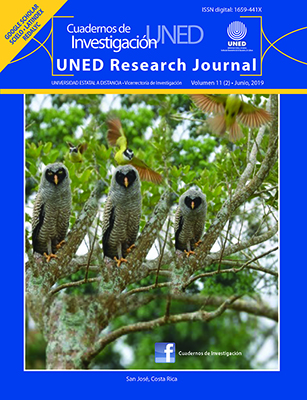Feeding behavior of Costa Rican velvet worms: food hiding, parental feeding investment and ontogenetic diet shift (Onychophora: Peripatidae)
DOI:
https://doi.org/10.22458/urj.v11i2.2195Keywords:
feeding behavior, Peripatidae, Panarthropoda behavior, undescribed Costa Rican onychophorans, parental investmentAbstract
We report, for the first time in onychophorans, food hiding, parental feeding investment and an ontogenetic diet shift two weeks after birth: from the parent’s adhesive used to capture prey, to the prey itself.
References
Barquero-González, J.P., Acosta-Chaves, V.J., Sotela, M.L., Villalobos Brenes, F., & Morera-Brenes, B. (2016). Photographic evidence of undescribed species of velvet worms (Onychophora: Peripatidae) from Costa Rica. UNED Research Journal, 8(2), 139-147.
Blackburn, D.G., Hayssen, V., & Murphy, C.J. (1989). The origins of lactation and the evolution of milk: a review with new hypotheses. Mammal Review, 19(1), 1-26. DOI: 10.1111/j.1365-2907.1989.tb00398.x
Estes, R. (1991). The behavior guide to African mammals: including hoofed mammals, carnivores, primates. California, U.S.A.: University of California Press.
Langer, P. (2002). The digestive tract and life history of small mammals. Mammal Review 32, 2, 107-131. DOI: 10.1046/j.1365-2907.2002.00101.x
Lawrence, J.F., & Newton, A.F., Jr. (1995). Families and subfamilies of Coleoptera (with selected genera, notes, references and data on family-group names). In Pakaluk, J. & Slipinski S. (Eds.), Biology, phylogeny and classification of Coleoptera. Warszawa, Poland: Muzeum i Instytut Zoologii PAN.
Mayer, G., Oliveira, I.S., Baer, A., Hammel, J.U., Gallant, J., & Hochberg, R. (2015). Capture of prey, feeding, and functional anatomy of the jaws in velvet worms (Onychophora). Integrative and Comparative Biology, 55(2), 217-227. DOI: 10.1093/icb/icv004
Monge-Nájera, J. (1995). Phylogeny, biogeography and reproductive trends in the Onychophora. Zoological Journal of the Linnean Society, 114(1), 21-60. DOI: 10.1111/j.1096-3642.1995.tb00111.x
Moseley, H.N. (1874). I. On the structure and development of Peripatus capensis. Proceedings of the Royal Society of London, 22(148-155), 344-350. DOI: 10.1098/rstl.1874.0022
Read, V.S.J., & Hughes, R.N. (1987). Feeding behaviour and prey choice in Macroperipatus torquatus (Onychophora). Proceedings of the Royal Society of London B, 230(1261), 483-506. DOI: 10.1098/rspb.1987.0030
Reinhard, J., & Rowell, D.M. (2005). Social behaviour in an Australian velvet worm, Euperipatoides rowelli (Onychophora: Peripatopsidae). Journal of Zoology, 267(1), 1-7. DOI: 10.1017/S0952836905007090
Sosa-Bartuano, Á., Monge-Nájera, J., & Morera-Brenes, B. (2018). A proposed solution to the species problem in velvet worm conservation (Onychophora). UNED Research Journal, 10(1), 204-208. DOI: 10.22458/urj.v10i1.2027
Ten Brink, H., & de Roos, A.M. (2017). A Parent-Offspring Trade-Off Limits the Evolution of an Ontogenetic Niche Shift. The American Naturalist, 190(1), 45-60. DOI: 10.1086/692066
Published
How to Cite
Issue
Section
License
Note: This abstract contains an incorrect copyright due to technical issues. Authors who publish with this journal agree to the following terms: Authors retain copyright and grant the journal right of first publication with the work simultaneously licensed under a Creative Commons Attribution License that allows others to share the work with an acknowledgement of the work's authorship and initial publication in this journal
All journal contents are freely available through a CC BY 4.0 license.
CC BY 4.0 is a Creative Commons: you can copy, modify, distribute, and perform, even for commercial reasons, without asking permission, if you give appropriate credit.
Contents can be reproduced if the source and copyright are acknowledged according to the Open Access license CC BY 4.0. Self-storage in preprint servers and repositories is allowed for all versions. We encourage authors to publish raw data and data logs in public repositories and to include the links with all drafts so that reviewers and readers can consult them at any time.
The journal is financed by public funds via Universidad Estatal a Distancia and editorial independence and ethical compliance are guaranteed by the Board of Editors, UNED. We do not publish paid ads or receive funds from companies.
